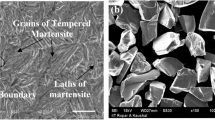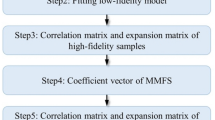Abstract
Considering the importance of failure prediction in the sheet metal forming design process, the ability to predict these failures by the four most common surrogate techniques, namely response surface methodology (RSM), radial basis function (RBF), kriging, and artificial neural network (ANN), was investigated. Firstly, a finite element model (FEM), which can substitute for the physical deep drawing and precisely predict thinning and rupture, has been developed. To ensure the accuracy of the FE model, a comparison between simulation results and experimental results is performed. In this study, the construction of training and test data is carried out by the Latin hypercube design (LHD) method via numerical simulation. Secondly, the four surrogate models are developed to predict thinning and fracture as a function of the six most critical parameters namely, blank holder force, punch section radius, die section radius, die fillet radius, blank thickness, and die blank friction coefficient. Finally, the performance and accuracy of these models are demonstrated by a goodness-of-fit test.












Similar content being viewed by others
Availability of data and material
The authors declare the availability of data and material.
Code availability
Not applicable.
References
Wankhede P, Suresh K (2020) A review on the evaluation of formability in sheet metal forming. Adv Mater Process Technol 6:458–485. https://doi.org/10.1080/2374068X.2020.1731229
Gutiérrez Regueras JM, Camacho López AM (2014) Investigations on the influence of blank thickness (t) and length/wide punch ratio (LD) in rectangular deep drawing of dual-phase steels. Comput Mater Sci 91:134–145. https://doi.org/10.1016/j.commatsci.2014.04.024
Atul ST, Babu MCL (2019) A review on effect of thinning, wrinkling and spring-back on deep drawing process. Proc Inst Mech Eng Part B J Eng Manuf 233:1011–1036. https://doi.org/10.1177/0954405417752509
Jeong HS, Park SH, Cho WS (2019) Influence of process variables on the stamping formability of aluminum wing nose rib. Int J Precis Eng Manuf 20:497–510. https://doi.org/10.1007/s12541-019-00112-1
Kardan M, Parvizi A, Askari A (2018) Influence of process parameters on residual stresses in deep-drawing process with FEM and experimental evaluations. J Braz Soc Mech Sci Eng 40:157. https://doi.org/10.1007/s40430-018-1085-9
Keeler SP (1961) Plastic instability and fracture in sheets stretched over rigid punches. Thesis, Massachusetts Institute of Technology
Goodwin GM (1968) Application of strain analysis to sheet metal forming problems in the Press Shop. SAE Trans 77:380–387
Bonatti C, Mohr D (2021) Neural network model predicting forming limits for Bi-linear strain paths. Int J Plast 137:102886. https://doi.org/10.1016/j.ijplas.2020.102886
Zhang R, Shao Z, Lin J (2018) A review on modelling techniques for formability prediction of sheet metal forming. Int J Lightweight Mater Manuf 1:115–125. https://doi.org/10.1016/j.ijlmm.2018.06.003
El Mrabti I, Touache A, El Hakimi A, Chamat A (2021) Springback optimization of deep drawing process based on FEM-ANN-PSO strategy. Struct Multidiscip Optim. https://doi.org/10.1007/s00158-021-02861-y
Wang H, Ye F, Chen L, Li E (2017) Sheet metal forming optimization by using surrogate modeling techniques. Chin J Mech Eng 30:22–36. https://doi.org/10.3901/CJME.2016.1020.123
Park J-W, Yoon J, Lee K, Kim J, Kang B-S (2017) Rapid prediction of longitudinal curvature obtained by flexibly reconfigurable roll forming using response surface methodology. Int J Adv Manuf Technol 91:3371–3384. https://doi.org/10.1007/s00170-017-9999-4
Sun G, Li G, Gong Z, He G, Li Q (2011) Radial basis functional model for multi-objective sheet metal forming optimization. Eng Optim 43:1351–1366. https://doi.org/10.1080/0305215X.2011.557072
Liu X, Liu X, Zhou Z, Hu L (2021) An efficient multi-objective optimization method based on the adaptive approximation model of the radial basis function. Struct Multidiscip Optim 63:1385–1403. https://doi.org/10.1007/s00158-020-02766-2
Kiani M, Yildiz AR (2016) A comparative study of non-traditional methods for vehicle crashworthiness and NVH optimization. Arch Comput Methods Eng 23:723–734. https://doi.org/10.1007/s11831-015-9155-y
Miranda SS, Barbosa MR, Santos AD, Pacheco JB, Amaral RL (2018) Forming and springback prediction in press brake air bending combining finite element analysis and neural networks. J Strain Anal Eng Des 53:584–601. https://doi.org/10.1177/0309324718798222
Greve L, Schneider B, Eller T, Andres M, Martinez J-D, van de Weg B (2019) Necking-induced fracture prediction using an artificial neural network trained on virtual test data. Eng Fract Mech 219:106642. https://doi.org/10.1016/j.engfracmech.2019.106642
Najm SM, Paniti I (2021) Artificial neural network for modeling and investigating the effects of forming tool characteristics on the accuracy and formability of thin aluminum alloy blanks when using SPIF. Int J Adv Manuf Technol 114:2591–2615. https://doi.org/10.1007/s00170-021-06712-4
You D, Liu D, Jiang X, Cheng X, Wang X (2017) Temperature uncertainty analysis of injection mechanism based on Kriging modeling. Materials 10:1319. https://doi.org/10.3390/ma10111319
Dang V-T, Labergère C, Lafon P (2019) Adaptive metamodel-assisted shape optimization for springback in metal forming processes. Int J Mater Form 12:535–552. https://doi.org/10.1007/s12289-018-1433-4
Palmieri ME, Lorusso VD, Tricarico L (2021) Robust optimization and Kriging metamodeling of deep-drawing process to obtain a regulation curve of blank holder force. Metals 11:319. https://doi.org/10.3390/met11020319
Park J-W, Kang B-S (2019) Comparison between regression and artificial neural network for prediction model of flexibly reconfigurable roll forming process. Int J Adv Manuf Technol 101:3081–3091. https://doi.org/10.1007/s00170-018-3155-7
Nouioua M, Yallese MA, Khettabi R, Belhadi S, Bouhalais ML, Girardin F (2017) Investigation of the performance of the MQL, dry, and wet turning by response surface methodology (RSM) and artificial neural network (ANN). Int J Adv Manuf Technol 93:2485–2504. https://doi.org/10.1007/s00170-017-0589-2
Huang C, Radi B, Hami AE (2016) Uncertainty analysis of deep drawing using surrogate model based probabilistic method. Int J Adv Manuf Technol 86:3229–3240. https://doi.org/10.1007/s00170-016-8436-4
Rajbongshi SK, Sarma DK (2019) A comparative study in prediction of surface roughness and flank wear using artificial neural network and response surface methodology method during hard turning in dry and forced air-cooling condition. Int J Mach Mach Mater 21:390–436. https://doi.org/10.1504/IJMMM.2019.103135
Simpson TW, Poplinski JD, Koch PN, Allen JK (2001) Metamodels for computer-based engineering design: survey and recommendations. Eng Comput 17:129–150. https://doi.org/10.1007/PL00007198
Amouzgar K, Strömberg N (2017) Radial basis functions as surrogate models with a priori bias in comparison with a posteriori bias. Struct Multidiscip Optim 55:1453–1469. https://doi.org/10.1007/s00158-016-1569-0
Zhang D, Zhang N, Ye N, Fang J, Han X (2021) Hybrid learning algorithm of radial basis function networks for reliability analysis. IEEE Trans Reliab 70:887–900. https://doi.org/10.1109/TR.2020.3001232
Narayanasamy R, Padmanabhan P (2012) Comparison of regression and artificial neural network model for the prediction of springback during air bending process of interstitial free steel sheet. J Intell Manuf 23:357–364. https://doi.org/10.1007/s10845-009-0375-6
Mckay MD, Beckman RJ, Conover WJ (2000) A comparison of three methods for selecting values of input variables in the analysis of output from a computer code. Technometrics 42:55–61. https://doi.org/10.1080/00401706.2000.10485979
Danckert J (1995) Experimental investigation of a square-cup deep-drawing process. J Mater Process Technol 50:375–384. https://doi.org/10.1016/0924-0136(94)01399-L
Author information
Authors and Affiliations
Corresponding author
Ethics declarations
Ethics approval
The article involves no studies on human or animal subjects.
Consent to participate
Informed consent was obtained from all individual participants included in the study.
Consent for publication
The publisher has the permission of the authors to publish the given article.
Competing interests
The authors declare no competing interests.
Additional information
Publisher's Note
Springer Nature remains neutral with regard to jurisdictional claims in published maps and institutional affiliations.
Appendix
Appendix
Rights and permissions
About this article
Cite this article
El Mrabti, I., El Hakimi, A., Touache, A. et al. A comparative study of surrogate models for predicting process failures during the sheet metal forming process of advanced high-strength steel. Int J Adv Manuf Technol 121, 199–214 (2022). https://doi.org/10.1007/s00170-022-09319-5
Received:
Accepted:
Published:
Issue Date:
DOI: https://doi.org/10.1007/s00170-022-09319-5




